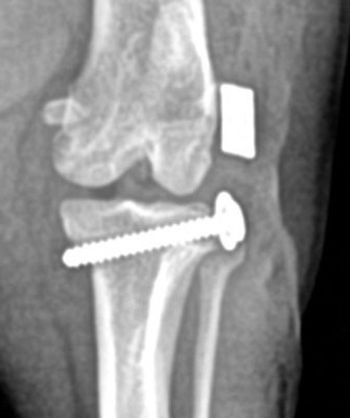Diagnosis (Dx) and Treatment (Tx)
A deep skin scrape, however, can be difficult to perform on a dog’s face, and particularly a puppy’s, because it is such a sensitive area, so if you don’t feel at ease doing it, you can begin treating the animal with isoxazolines.
“If you think [a dog] has demodex, but you’re not comfortable doing the diagnostics, then you can certainly just treat them as is, and see if they have a maybe/might response . . . and then go from there,” she said. “In the world we live in . . . we have no more excuses. Just give [isoxazolines].”
Secondary infections should also be treated, and you must look for underlying causes of immunosuppression in dogs over 2 years old, Miller said, because something must be predisposing the animal to the disease.
Dermatophytosis (ringworm)
Hx
Ringworm, which is variably pruritic, is most often seen in immunocompromised dogs or farm dogs.
PE
According to Miller, the disease can vary in appearance and include scaling or crustiness and raised erythematous nodules and kerions. “You have these very focal, raised, annular, swollen-looking lesions. Dermatophyte can do that. Ringworm is not always alopecia and scaling; ringworm can do some funky stuff in a dog and a cat.”
Dx and Tx
A trichogram, Miller noted, is an excellent tool for diagnosing ringworm. Although the classic fungus associated with dogs and cats is Microsporum canis, facial ringworm is more commonly caused by Trichophyton spp, Microsporum gypseum, and Microsporum persicolor, which can be acquired from exposure to mice and rats. Because Wood’s lamp detects only M. canis,it is not typically useful for diagnosing facial ringworm.
Treatments include1:
- Terbinafine (30-40 mg/kg po qd)
- Ketoconazole/fluconazole (5-10 mg/kg po qd)
- Topicals: miconazole + chlorhexidine, terbinafine, lime sulfur
Facial discoid lupus erythematosus (FDLE)
Hx
“[FDLE] is probably the most common autoimmune disease you’re going to see,” Miller said. The classic history consists of disease that progresses slowly and tends to become worse in the summer, as most autoimmune disorders are exacerbated by exposure to ultraviolet light.
PE
The nose is typically most affected by FDLE, although it can reach the bridge of the nose and affect the periocular area. Signs of disease include bilaterally symmetric loss of nasal cobblestone, depigmentation (from black to gray to pink), and erosions that subsequently cause oozing and crusting.
Dx and Tx
If a dog presents with those signs, Miller strongly suggests that a biopsy be done to ensure it is indeed FDLE. Because a dog’s nose is extremely sensitive, the biopsy requires heavy sedation, and she often recommends general anesthesia.
If the client cannot afford a biopsy, “you can try to rule out the other [causes]. . . . Make sure . . . to do a trichogram to look for ringworm, do your cytology to see if there’s bacterial infection you can clear. Try to rule everything else out if you can, then you can presumptively treat it if you must,” she said, adding, “I’m perfectly fine with you presumptively treating things, but if you have the chance, biopsy is really the best.”
Treatment options for FDLE include avoiding sunlight and1:
- Systemic immunosuppression with doxycycline/niacinamide
- Topical immunosuppression with betamethasone (bid, until remission) or tacrolimus (SID, forever)
References
- Miller J. Let’s face it: how to diagnose and treat derm diseases of the face. Presented at: Fetch dvm360® Conference; April 22-24, 2022; Charlotte, North Carolina.
- Ward E, Panning A. Demodectic mange in dogs. VCA Animal Hospitals. Accessed May 4, 2022. https://vcahospitals.com/know-your-pet/mange-demodectic-in-dogs






